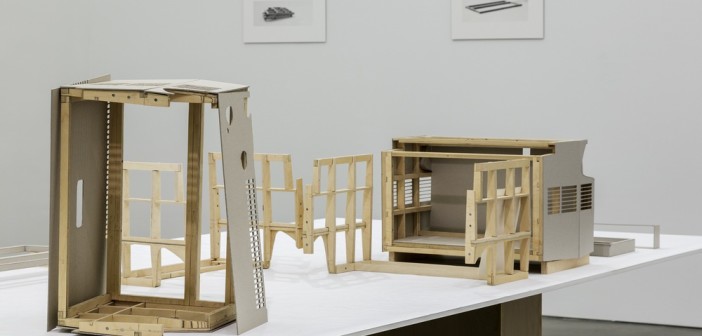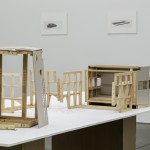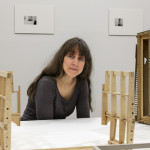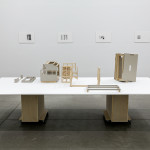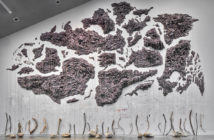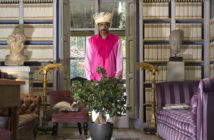Sarah Bapst’s work is compact, unhurried, and subtle. It is the opposite of the work in the joke that named Big Red & Shiny.1 Being the quiet person in the room can be a hard road though. From the seventeenth-century salon to modern biennials, being able to stand out in a group is a key skill to have as an artist. If your work is small or your work takes longer than a few seconds to figure out, you may find it hard to compete in an environment that often rewards a particular type of giant empty flashiness that passes as contemporary art.
Like much art, Bapst's display is easy to describe, but harder to explain. Most simply put, she took an air conditioner that she found and explored its form. More acutely, she took it apart, measured the thing, looked at it from her perspective as an artist, imitated it with model making materials, and took some photos of the resulting sculpture. But really, she cracked the code of this industrial product transforming the commodity into a personal expression.
Bapst has created a work that approaches minimalism’s consideration of the objective reality of space. Her object has the wrong rhythm to be truly minimalist though. It starts and stops for reasons that are not clear to the viewer, as it is seemingly unrelated to the original air conditioner; a suitable situation if this is a personal exploration of space and form. It certainly not a strict patterned goal orientated work that instructs the viewer to have one opinion.
Instead of working in the manner of Richard Serra’s more obvious works—aping the materiality of his inspiration or literally building up drawings to resemble the finish of a used, aged sheet of steel—Bapst considers the size, rhythm, the flow of the object. Like Serra’s best work, the skeleton she presents to us becomes a dance and the photographs become moments in her sculptural choreography. By photographing the sculpture, Bapst has created a hermeneutic circle of interlocked interpretations. In trying to capture the sculpture’s progress through space, she creates a fiction that both denies and helps solidify the reality of the object as presented. The photographs translate the object through further reductions and editing, forcing both the sculpture and the photographs to be both subject and object.
The sculpture implies a grid, but not an optical display of squares,2 instead the sculpture implies a series of coordinates. Bapst considers the type of data that the machine that forms air conditioners needs to function. She casually limns this hard computer edge and inviolate precision, but her work comes out as a calm and casual composition filled with shoddy human manufacturing, at least compared to the robotic object she cites. It seems to evolve through her hand rather than by allying with a concept like Duchamp’s readymade. An evident portion of her creative process is the interruption. The air conditioner is left in a state that is neither finished nor unfinished. It’s form and formless. It has sprezzatura, being the studied embodiment of casualness.
This air conditioner has lost its opacity but it isn’t quite transparent. It hides what it exposes, parts are clearly visible but are still not quite uncovered. The scale messes with the eye, leaving the size undefined. Should we take this size to be literal? The scale of art often proposes a devious intimacy. It could easily be scaled up to the size of a building, creating an ambiguity between architecture and sculpture. Curator Helen Molesworth discusses the pencil markings left on the object in her interview with Bapst in the catalogue. Should we be that close to the object? The table sized plinth and the always-present guards prevent that from happening.
_____________
Every two years the ICA holds the James and Audrey Foster Prize by creating a short list of Boston artists of "exceptional promise" and establishing a panel of professionals to assess those artists. All four of the short-listed artists exhibit at the ICA, and one is announced as the James and Audrey Foster Prize winner.
This year’s short list is Sarah Bapst, Katarina Burin, Mark Cooper, and Luther Price.
This year’s jury is Mark Dion, artist; Paul Ha, director of MIT List Visual Arts Center, Cambridge, MA; and Ali Subotnick, curator at the Hammer Museum, Los Angeles, CA.
Over the next four days we will be running a review for each of the artists on display. They will be in alphabetical order.
We here at Big Red & Shiny congratulate Katarina Burin for winning this year’s James and Audrey Foster Prize.
- Sarah Bapst, Untitled, 2008, Plywood, cardboard. Courtesy the artist. Photo: John Kennard.
- Sarah Bapst with Untitled at the ICA
- Installation of Untitled at the ICA
[1] If you can't do it right, do it big. If you can't do it big, do it red. If you can't do it red, do it shiny!
[2] Like the grids that Rosalind Krauss discusses in her essay Grids (PDF) (October 9, Summer 1979). This grid is not here for "its hostility to literature, to narrative, to discourse."

